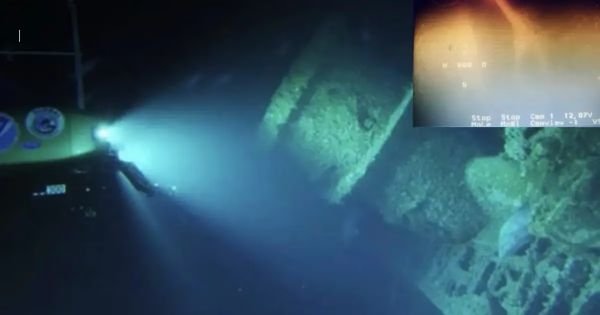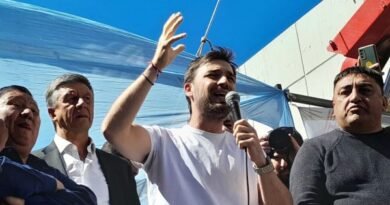Argentine Congress and Simon Wiesenthal Center seek answers on ‘Submarine’ wreck
[ad_1]
Argentine Congress and Simon Wiesenthal Center seek answers on ‘Submarine’ wreck
Congress urges the Government to fulfill legal obligations and raise thought-provoking questions, while the Simon Wiesenthal Center emphasizes transparency. Photo: Prefectura Naval Argentina
By Laurence De Mello in BUENOS AIRES
The 2022 discovery of a suspected WWII U-boat in Argentine waters has ignited an intense political debate within the closed corridors of the Argentine Government, resuscitating embarrassing historical ties between President General Juan Domingo Peron and Nazi Germany.
The shattered amphibious craft, lying in shallow waters close to the beaches of Costa Bonita and Arenas Verdes off the coast of Buenos Aires, could confirm claims that leading Nazi’s escaped to Argentina by submarine in the closing months of WWII.
Read also: German WWII sunken submarine found off Necochea
News of the shipwreck and the subsequent reluctance by the Argentine Government to conclude a transparent investigation to identify the vessel, has prompted congressional members of the political opposition party ‘Juntos Por el Cambio’ (Together for Change), to urge the current Peronist administration to verify if the wreckage was part of the notorious Pack of wolves convoy of WWII.

Argentine Naval Prefecture investigates the wreck in 2022 – Credit Prefectura Naval Argentina.
In a highly confidential Government document obtained exclusively by MercoPress, Members of Argentina’s National Congress have made baffling remarks, shedding light not only on Argentina’s cosy historic relationship with Nazi Germany, but the possible covert smuggling of Nazi’s by the United States Government via Argentina to the United States of America.
Identifying the vessel has become a top priority, to determine the country of origin, date of sinking and whether there were any important passengers on board who may have disembarked in Argentina before the boat was scuttled.
Likewise, the deputies are calling for information regarding possible cargo, reminding the Government of its legal obligation to identify and assess any potential hazardous materials which may have been onboard, including live torpedoes and uranium, particularly if the vessel is confirmed to be a U-Boat

Juan and Eva Peron gave refuge to Nazi escapees.
Peron’s interest in German atomic technology is well-known and one U-Boat (U-234) captured by the allies while bound for Japan in May 1945, was found to be carrying 1,200 pounds of Uranium Oxide, a vital ingredient for an atomic bomb.
Following the discovery and reporting of the wreck in March 2022 by Abel Basti an investigative journalist and director of the research group ‘Eslabon Perdido’ (Missing Link), the Argentine Naval Prefecture secured control of the wreck area and conducted an extensive and meticulous inspection of the hull and wreckage.
At a depth of only 28 meters, a remotely operated vehicle (ROV) was used with tactical divers to capture images of the craft and surrounding debris, dispersed over an area of seabed 80-meters-long and 10-meters-wide. The dives yielded over eight hours of underwater footage and thousands of murky images.

Fabio Bisciotti works for the Pentagon in the identification of American ships during World War II in the Adriatic Sea – Credit: LNI
Despite the initial Government inquest, costing over 60 million Argentinian Pesos (US$300,000) the Argentine Government has refused to publicly disclose the identity of the vessel.
To tackle prolonged delays, Abel Basti enlisted two independent experts to examine the wreck and materials obtained by the Naval Prefecture.
Dr. Martin Canevaro, President of the Professional Council of Naval Engineering in Argentina and Dr. Fabio Bisciotti, an international naval wreck identification and recovery specialist from The Lega Navale Italiana. The experts presented pro-bono reports, in which they identified what appears to be a ‘periscope’ and a Conning Tower.
Dr. Biscotti, an internationally recognised authority in the field, stands as one of the world’s foremost experts in investigating and identifying WWII wrecks. He has undertaken multiple prestigious assignments to investigate wreckage, particularly from the Second World War. His expertise has been solicited by the United States Pentagon and the British Royal Navy.
The cover letter of Dr. Biscotti’s 2022 report states:
Final impression – we found various pieces attributable to a submarine. The investigation needs to be revisited in depth to determine the actual make and model.”
”We categorically state it is not a ship.
MercoPress contacted Dr Bisciotti to ask if he still stands by his report of 2022:
“Of course, my opinion remains unchanged. This wreck holds immense significance, showing a multitude of extraordinary features that deviate from those found in conventional ships or boats. Numerous characteristics strongly suggest its classification as a submarine, notably, a prominent conning tower deflector, a distinctive feature of U-Boats. Only through close examination can we determine its origin.
“Conducting dives at this site presents substantial challenges due to the muddy seabed and turbid water. The position and relentless strong currents impede the natural clearing of mud and debris, severely restricting visibility. But it is imperative to undertake a comprehensive investigation to precisely ascertain the origin of this wreck.

Periscope found on the mysterious Wreck – Credit: Argentine Naval Prefecture
Researchers believe the Government’s hesitation to disclose information, especially only months before the October 2023 presidential elections, may be due to the flailing Government’s Peronist background and its unwillingness to address the possibility of a Nazi U-boat in Argentine waters.
Such reluctance by the Government has fueled growing suspicions of a potential political cover-up, accentuated by a striking absence of required documentation pertaining to any sinkings or wrecks in the area where the vessel lies.
Even before taking over the country in 1947, Juan Perón as Argentine Vice President, encouraged various high-ranking Nazi’s to take refuge in Argentina at the closing of the war and later, providing fake ID’s, travel documents, lodgings and expenses. Most of the documents that Peron would have arranged were issued through the International Red Cross and the Vatican.
Dr. Josef Mengele, (Angel of death of Auschwitz) Dr. Carl Vaernet (of the Pink Triangle at Buchenwald) Dr Aribert Heim (Butcher of Mauthausen) and Erich Priebke, are among Nazi’s who escaped to Argentina under the protection of Juan and Eva Peron.
Adolf Eichmann, known as the ‘architect’ of the Holocaust, lived in Argentina for over a decade. In 1960, he was kidnapped off the streets of a Buenos Aires suburb by a team of Israeli secret service agents. Within hours he was drugged and ‘smuggled’ back to Israel for trial without the knowledge of the Argentine authorities, who later admitted to being furious. Eichmann was executed in Israel in 1962.
Since 1982, while working as a national news correspondent, Argentine journalist Abel Basti has been actively investigating Argentina’s concealed Nazi history.
Through conducting hundreds of witness interviews and obtaining access to tens of thousands of documents from South America, Russia, and the United States of America, Basti has authored 12 books on the subject. Over 20 years of expertise in analysing coastal and maritime wreck coordinate maps led him to the find.
However, Basti’s theories on Nazi’s and U-boats being scuttled off the Argentine coast have on occasion been met with ridicule. Despite widespread skepticism, Basti’s extensive research found its way into the History Channel series Hunting Hitler, and served as the foundation for the internationally bestselling book Grey Wolf.
In 1994, Basti’s hometown of Bariloche became globally infamous when an ABC TV crew exposed the identity of a local German resident. It was none other than Erich Priebke, a former SS officer who commanded the ruthless mass execution of 335 civilian men and boys at the Fosse Ardeatine in Rome in March 1944.
The discovery of the SS Officer responsible for enforcing the Roman massacre, living openly in Bariloche, caused widespread outrage in Italy and sparked global condemnation. After a lengthy four-year extradition process, where community neighbours had rallied to object to his arrest, his return to Italy marked a significant step towards justice. However, the subsequent trial revealed a disturbing fact: Priebke had fled to Argentina in 1946, aided by Alois Karl Hudal an Austrian Catholic Bishop based in Rome, who helped establish ODESSA (Organization der ehemaligen SS-Angehörigen), a covert network for SS members to evade capture.
Dr. Ariel Gelblung, Director of The Simon Wiesenthal Center Latin America, shared exclusive insights with MercoPress, emphasizing the urgent need for action from the Argentine Government:
’In situations where the Government remains silent on a specific issue, such as the recent discovery of what may be a WWII submarine, it is crucial for the Government to respond to any concerns raised, regardless of any historical, political, or financial constraints. Failing to do so only fuels speculation and suspicion.’’

Dr Ariel Gelblung – Director of The Simon Wiesenthal Centre Latin America – Credit: SWC
Truth requires acknowledging both the positive and negative aspects of a story and maintaining objectivity when examining historical events, particularly those related to WWII. While no Government is perfect, we cannot ignore the grave and ugly mistakes that have been made in the past.”
‘’Although we are not connected to this investigation, preferring to wait for the findings, which we hope to examine at the proper time if permitted, we recognize the Argentinian Government’s responsibility to respond to this matter. Transparency and communication are essential to move forward to gain a clearer understanding of history, as well as the identity of this vessel.”
Independent of the findings, the Argentine Government’s delay in naming the vessel could be in violation of international law.
According to the provisions of the United Nations Convention on the Law of the Sea (UNCLOS), military shipwrecks that are less than 100 years old are deemed to be the Sovereign Immunity property of the country to which they belong. As the contested wreck is located within Argentine waters, Argentina has a legal obligation to determine the age, origin and identity of the wreck and must investigate the fate of its crew and passengers. Any undocumented sunken vessel must be treated as a potential crime scene and reported to the local judiciary, to initiate an inquest in accordance with established procedures.
Nevertheless, since receiving the expert reports in 2022, the Argentine Ministry of Security has halted any further investigations by the Argentine Prefecture, leaving the question of ownership unresolved.
In their recent communication to the Argentine Executive Branch, congressional members sought clarification on the Government’s adherence to the legal obligation of reporting the discovery of the wreck to the judiciary. Additionally, they raised thought-provoking questions:
“We want to know If our Diplomatic Representation in Berlin has officially informed the Government of the Federal Republic of Germany about the discovery of the wreck in question and inquired about the possibility of it being a type IX submarine of the then Kriegsmarine.”
“If proven to be a German submarine, it has been suggested that it could have been captured by the United States of America and after taking German scientists and researchers aboard it may have taken refuge momentarily in Argentina while on route to the United States of America, within the framework of ‘Operation Paper Clip’, through which characters such as the main leader of the American space race, Dr. Werner von Braun were taken. Others who arrived in Argentina through other routes included Nobel Prize in Chemistry Friedrich Bergius, the nuclear specialist Ronald Richter and the jet aircraft designer Kurt Waldemar Tank and members of his team (Pulqui II Project), the latter three having entered with Argentine passports under other people’s or assumed names.”
“If the vessel in question is proven to be German-flagged, consideration must be given to any cargo it contained as booty of war and therefore, sovereign and imprescriptible property of the Argentine Republic, attentive to the fact: our nation was on the allied side towards the end of the 2nd World War”.
The document alluded to the possibility of Nazi treasure.
“Did the ROV detect any signs of penetration of the vessel, suggesting an attempt to more easily access and remove valuable cargo such as gold ingots, bronze, copper, silver, platinum, uranium, cobalt, etc.?”
In October 2022, ‘Eslabon Perdido’ took pro-active measures to expedite the identification process by submitting the expert reports and a letter to Dr. Ulrich Sante, the German Ambassador to Argentina:
“The reports presented by both experts unequivocally confirm that the wreck is indeed a submarine.”
“As finder of the vessel, in accordance with current legislation, I solicit the German Government to confirm whether it lays claim to ownership of the submarine or if it manifests ignorance.”
“If Germany claims ownership, I request authorisation for Dr. Bisciotti and his team to conduct underwater inspections and collection of samples for analysis.…. and request authorisation to retrieve the attack periscope for safe keeping, which has separated from the tower and lies loose among the remains.’’
Mr. Basti did not receive any response for 7 months, until after we contacted the German Embassy in Buenos Aires to enquire why. Within 48 hours of our enquiries, the German Embassy wrote to Mr. Basti. We also received a reply:
We have acknowledged the reports regarding the mentioned submarine wreck. The German Embassy in Buenos Aires had already communicated with Mr. Basti. As of now, we have not discovered any evidence suggesting that the submarine wreck in question is of German origin.
While claims of Nazi Gold and escaped leaders may evoke offense and skepticism among some, there are certain indisputable facts that transcend mere dismissals as ‘conspiracy theories’.
In the shallow waters off the Argentine coast rests a fragmented vessel, its identity and origin veiled in mystery. The discovery aligns with ‘Eslabon Perdido’s’ assertions, establishing a compelling link between the location and the covert transportation of prominent Nazi figures from Europe via submarine. Extensive pre-inquest investigations, led by two experts have unequivocally determined that the submerged object is not a boat, but a submarine.
Members of the Argentine congress have urged the Government to fulfill its legal obligations while raising thought-provoking questions which hint at further hidden truths. While the Simon Wiesenthal Center has underscored the significance of Government transparency and the need for definitive answers.
The ongoing absence of a statement from the Argentine Government intensifies confusion and speculation, underscoring the imperative for a comprehensive investigation in accordance with both Argentine and International law.
[ad_2]
Source link




